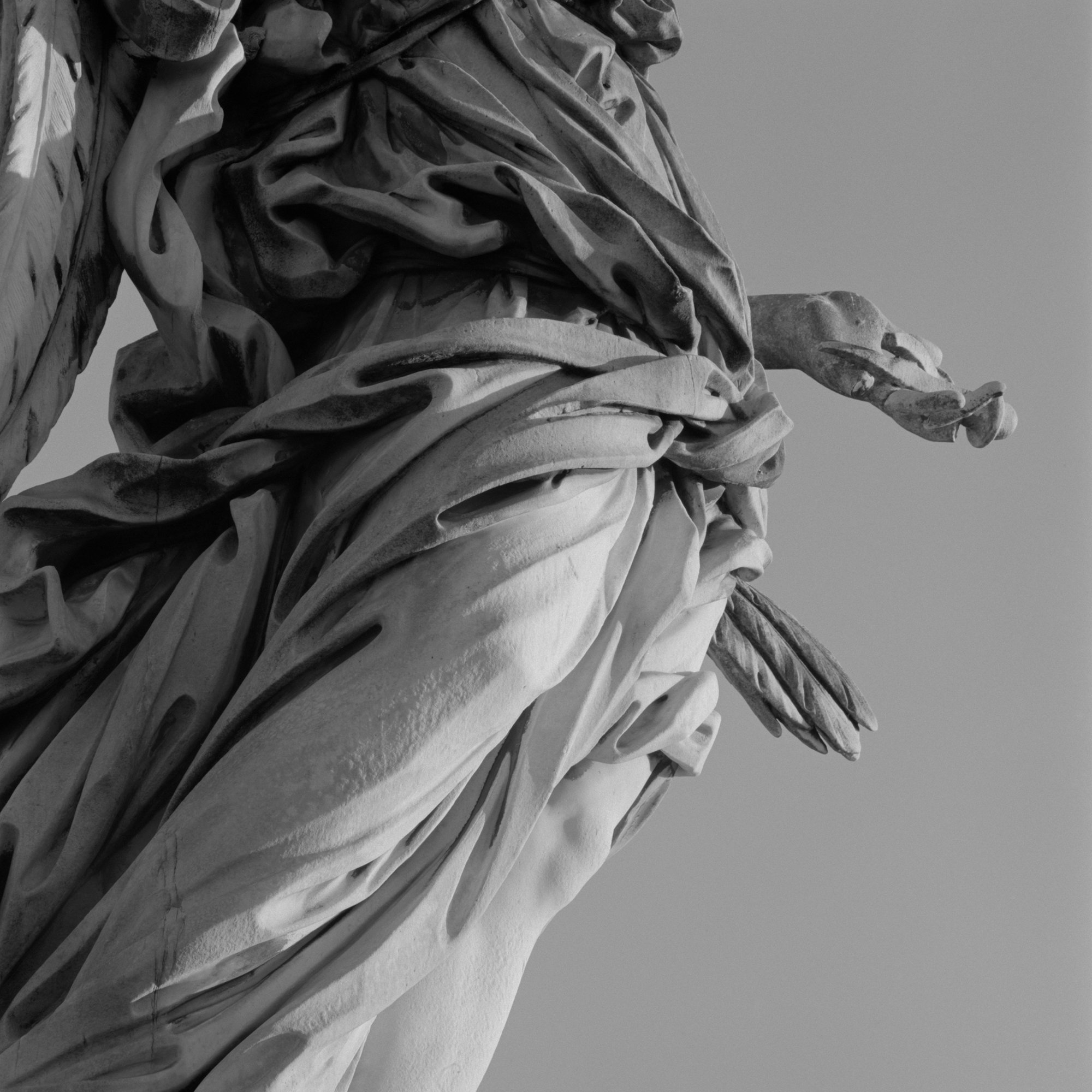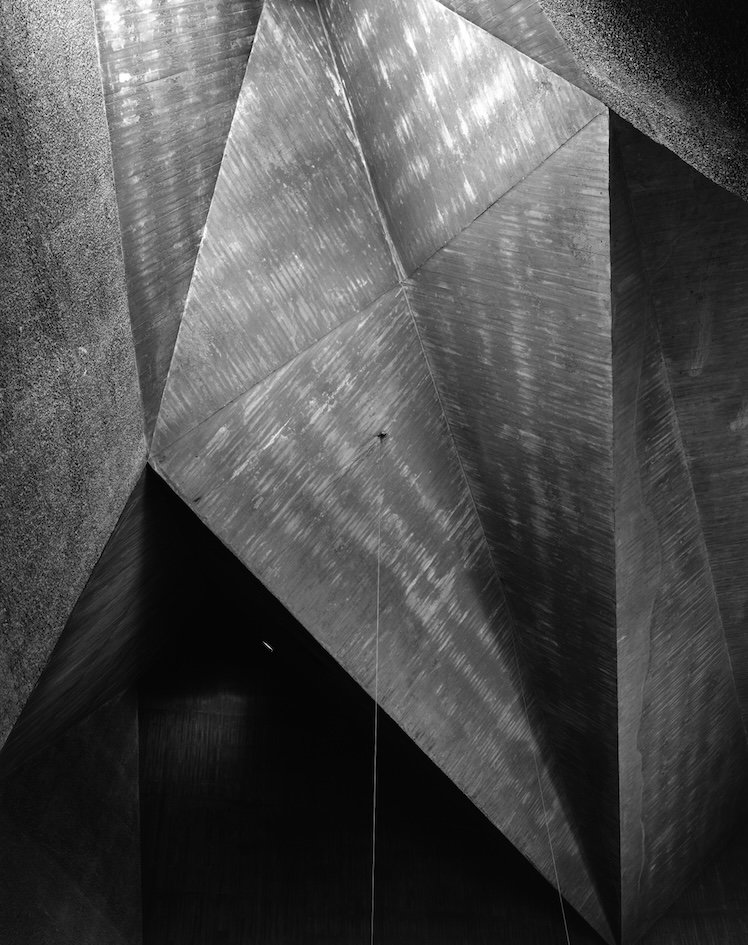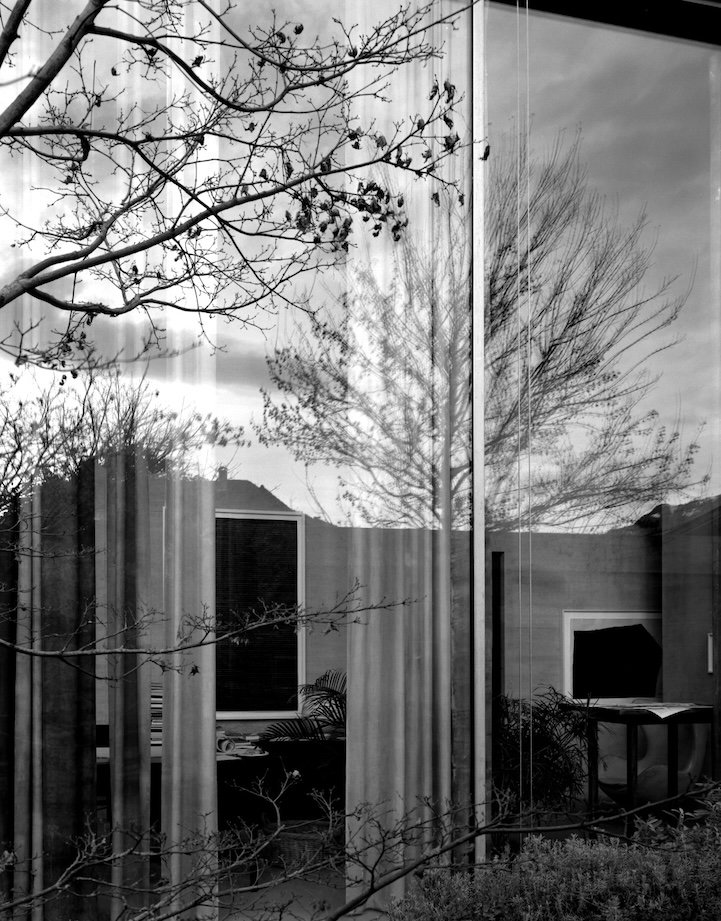
On the last page of Hélène Binet (Lund Humphries), a book of the photographer’s work released this past spring, an image, shot in Binet’s signature black-and-white format, depicts an installation by the late architect Zaha Hadid. The caption tells us that the photograph was made in 2000 at the Académie de France, located at Rome’s Villa Medici, and that the taut lines stretching across the frame are red twine.
In the foreground, a stone statue leans backward, away from its shadow, into the diffuse light of what might be an early afternoon sun, its eyes shrouded by a thicket of thread. The eyes are—or rather, would be—our point of access into the statue. In looking at them we would likely understand the sculpture as something like us. We would surmise something from the way the eyelids sat, whether the eyes were closed or open, and which way they pointed. We would connect.
In denying us that access, Binet declares her authority: She, not the content, shapes the image, as well as how we enter into it. And she introduces the element of abstraction—not totalizing, but powerful—leaving us to build the rest of the scene in our minds.

Over the past three decades, Binet has become celebrated for her distinctive photographs of the built environment, as Marco Iuliano and Martino Stierli—the University of Liverpool School of Architecture’s master’s program director and the Museum of Modern Art’s chief curator of architecture and design, respectively—discuss in the essays that open the book. Binet employs a large-format camera and photosensitive film that she develops in her London darkroom: an analog method she started using in the early 1980s and has continued to embrace even as photography becomes increasingly digitized. She has photographed in-progress and historic structures, as well as well-known works by architects such as Le Corbusier and Peter Zumthor.
But Binet does not deal in typical portraits of buildings. She’s instead guided by, according to Stierli, a “phenomenological understanding of architecture.” That understanding—expressed formally by fragmentary photographs, often assembled into sequences that show material detail—has produced a body of work that captures the feeling of architecture, in addition to its appearance. Binet’s framing and arrangements invite viewers to imagine the obscured physical and sensorial aspects of a building: the smells, the textures, the temperatures, and the sounds around and underfoot.
Stierli locates this quality of Binet’s work across a tripartite “taxonomy of architectural photography,” which stems from the photographer’s own conception of her practice. The first branch consists of “commissions by contemporary architects with the objective of faithfully documenting their work,” the second of photos commissioned by architects interested in “Binet’s self-guided interpretation,” and the third of subjects she selects, “guided by her own interests and priorities.” “What all of these approaches have in common,” Stierli writes, “is the understanding that architecture cannot be reduced to a (photographic) image.”
It’s easiest to witness that conviction in work belonging to the third category, which includes studies made in the early 1980s of Sperlonga, Italy, the town of whitewashed stone where Binet lived with her family after they arrived in the 1960s from her native Switzerland; images of Hadrian’s villa shot in 2019, in which the sky recedes from foreground to background through an oval-shaped opening; and color shots, from 2018, of a garden’s walls in Suzhou, China, so textured yet one-dimensional that they might be mistaken for a Gerhard Richter canvas.
In these cases, it would have been impossible for the architect to be involved in the creation of the image—he is long dead—which grants Binet the freedom to make it as she sees fit. What’s interesting to glean from the book’s photographs—which are divided into the categories “traces,” “passage of light,” “at play,” “narratives,” “sequence,” and “abstraction”—is how the approach she developed within that freedom conditioned the work in the first two categories of Stierli’s taxonomy.

Commissioned “documentary” photographs of Daniel Libeskind’s House Without Walls (1986) and Hadid’s Vitra Fire Station (1991) pull the viewer inward into an unfamiliar landscape. They omit context; they are almost all form. A triptych of Zumthor’s thermal baths in Vals (2006), created in Binet’s “symbiotic association” with the architect, suggests that architecture might be primarily composed of ephemeral planes of light and air, and less so of the physical elements chosen and placed by a designer.
Elsewhere, a series made at Gottfried Böhm’s St. Gertrude and St. Matthaüs parish church (2020)—the book does not specify whether these were made for a commission—distills the concrete buildings into planes that improbably twist and fold into themselves. Surely the artistic impulse behind these images comes from the same independence of vision that led Binet to make a photograph of Dimitris Pikionis’s paths at the Acropolis, 21 years after the architect’s death, which reads like an aerial shot of a tract of farmland.
Both Iuliano and Stierli stress the importance of Binet’s partiality to “incomplete” images like these. The distance that abstraction creates elicits a physical and psychic appreciation of her images, which double as reminders of architecture’s ability to condition our lives. Without Binet’s impulse toward abstraction, they suggest, there would not be enough room in her photographs for viewers to fill in those sensorial gaps. That impulse is a kind of generosity, and it is rooted in the photographer’s ability to move toward light and shadow, like that statue, not just with her eyes but with her whole body. The camera follows.